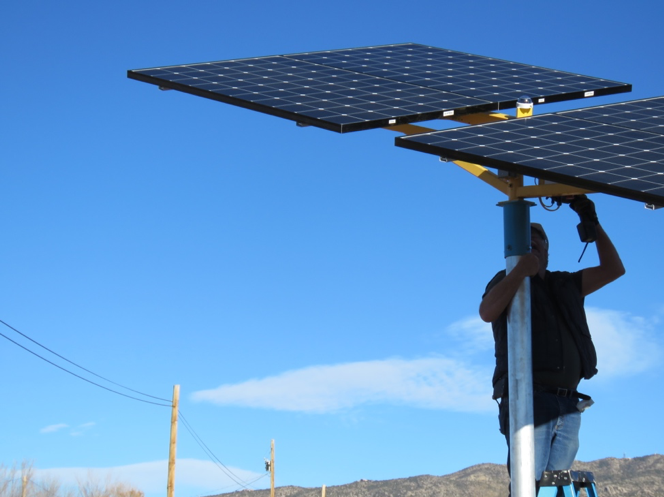By Ken Hughes
Despite centuries of passively capturing the sun’s warmth such as at Acoma’s Sky City, where homes are optimally oriented to 5 degrees east of due south, solarizing Native American homes these days is rare. Native communities agree on the desire to turn toward solar for their energy needs and away from continued reliance on gasoline, propane and natural gas.
A new solar technology, developed with tribal communities in mind, is standardized, easy to install, and locally financed. Coupled with a novel financing too, this simple and cost-effective technology can be installed in your yard soon.
Many Native Americans who want to install solar panels find them too expensive or their roofs cannot handle the extra weight. And while it’s exciting that new large solar arrays are being installed throughout the state, they do not help folks reduce their own electric bills.
Three types of solar devices are best suited for tribal communities. The most typical is rooftop mounted solar panels. Many solar firms in the Southwest offer to emplace panels for homeowners with qualifying credit status to cover panel and installation costs. The second type is a ground mounted array, which is a good alternative for those with plenty of cash, land and especially if one wants to track the sun. The third type is a pole mounted array, mainly meant for factory built homes, which are one of six homes in New Mexico, a major underserved market.
In 2019 Nambe Pueblo, collaborated with Jemez Mountains Electric Coop, the State Energy Office and the nonprofit Cornerstones to site PV on a Pole arrays at the homes of two septuagenarian pensioners. Each device is anchored to the ground with a five-foot steel anchor. A ten-foot pole is screwed into the anchor. And rack-mounted solar panels are placed atop the pole, oriented to the sun. The first two prototypes are now up and operating; solar output data confirm that these arrays cover all or most of the households’ electricity needs.
The plan is to install more PV on a Pole arrays at factory built homes and paid for initially with grants, then usher in an on-bill repayment mechanism.

What’s the cost and how to pay for it? At this prototype stage, pole-mounted solar arrays should cost around $5,000. While some folks can write a check for that, most cannot. Enter on bill financing, which allows utilities to front the costs and then have participating customers repay the costs over time. If utilities do not step up to offer such financing, tribes or local governments should explore use of a monthly billing mechanism such as the water bill to do so.
On bill financing can cover the costs not only of solar but significant energy efficiency improvements such as heat pumps for heating, cooling and hot water, and even electric car chargers. Should the utility choose to adopt this approach, its customers can look forward to adopting a suite of clean energy measures and choosing an easy way to pay for it.
An on-bill financing program allows a customer to repay the costs for clean energy improvements on the regular monthly utility bill. It takes advantage of the familiar and convenient payment mechanism, and factors in the solar utility savings so that the utility savings outweigh any new payments.
On bill programs around the country including over 100 rural electric coops, including Nora in Chama and Roosevelt in Portales, NM. These programs have invested over $2 billion nationwide in significant energy improvements with default rates ranging from 0% to 3%.
A successful on-bill financing program incorporates flexibility to invest in clean energy while maintaining five design principles. First, loans to program participants should be bill neutral or better, and interest rates should be set at or below five percent, in order to assure cash-positive flow for participants. Second, participants should not be required to make upfront payments for home improvements. Third, programs need strong quality assurance plans that keep contractors accountable. Fourth, programs should finance a “whole house” set of energy efficiency and solar energy measures to maximize cost-effective savings. And fifth, to be more accessible to the poor, programs have to offer alternative methods of loan underwriting, such as good bill payment history in lieu of a credit check.
On bill financing can be extended beyond the electric utility to other clean energy improvements related to gas or water bills. Insulation upgrades, heat pump installations for heating, cooling and hot water could all be financed the the utility, tribe or local government and paid back incrementally by the customer. When tied to the meter instead of the homeowner or renter, it does not require needing a high FICO store or other good credit history.
Bringing new solar technology and on bill financing to New Mexico will bring us closer to the day when any New Mexican family, no matter their income or ownership status, can afford to live in a home powered by the sun.
Ken Hughes is the Director, Operations and Development, for the Coalition of Sustainable Communities NM. He previously served in the NM Energy, Minerals and Natural Resources Department as a Clean Energy Specialist.
Tags: Finance, Policy, Technology
Categorised in: Featured


